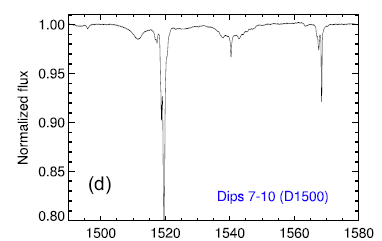Mysterious happenings around the star KIC 846852

The Kepler satellite was designed to search for Earth-sized planets in the habitable zone of stars by measuring dips in a star's brightness as orbiting planets move across the stellar disc (transits). Its sensitive camera stares at more than 150,000 stars towards the constellations of Cygnus and Lyrae, and so far has found over 5000 exoplanet candidates. But Kepler also monitors the light fluctuations in all the other stars, even dips not caused by transits, and has found some bizarre situations.
Perhaps the strangest is the case of KIC 846852, an otherwise normal star slightly larger than the Sun that has exhibited significant, irregular dips in the flux that last as short as a few days or as long as eighty days, and are as deep as 20%. The source is so far unique in the Kepler database. The irregular and extreme nature of the episodes excludes planetary transits, and other suggestions have ranged from a catastrophic collision between planets that released a cloud of obscuring debris, to the presence of a huge alien artifact like a so-called "Dyson sphere!"
CfA astronomers Mike Dunham, Glen Petitpas, and Lars Kristensen, and their colleagues, realized that if a cloud of dust particles were present in the stellar system, it should be detectable at submillimeter and millimeter wavelengths because of its warm temperature. They used the Submillimeter Array and the James Clerk Maxwell Telescope to search for any such dust. They found no signs of it. They can therefore limit the amount of material to less than about one tenth of the Moon's mass (at least in the regions mostly likely to host dust) and fewer than about eight Earth-masses throughout the entire stellar system. According to the scientists, such small amounts of dust make the catastrophic planetary collision scenario very unlikely, but might be consistent with the picture of the complete breakup of a cluster of about thirty Halley-like comets.
The cause of such a dramatic event, however, is not understood, and meanwhile other imaginable scenarios are still allowable, but the new results put a firm limit on the amount of dusty material around this strange and unique star.
More information: M. A. Thompson et al. Constraints on the circumstellar dust around KIC 8462852, Monthly Notices of the Royal Astronomical Society: Letters (2016). DOI: 10.1093/mnrasl/slw008
Journal information: Monthly Notices of the Royal Astronomical Society Letters
Provided by Harvard-Smithsonian Center for Astrophysics





















